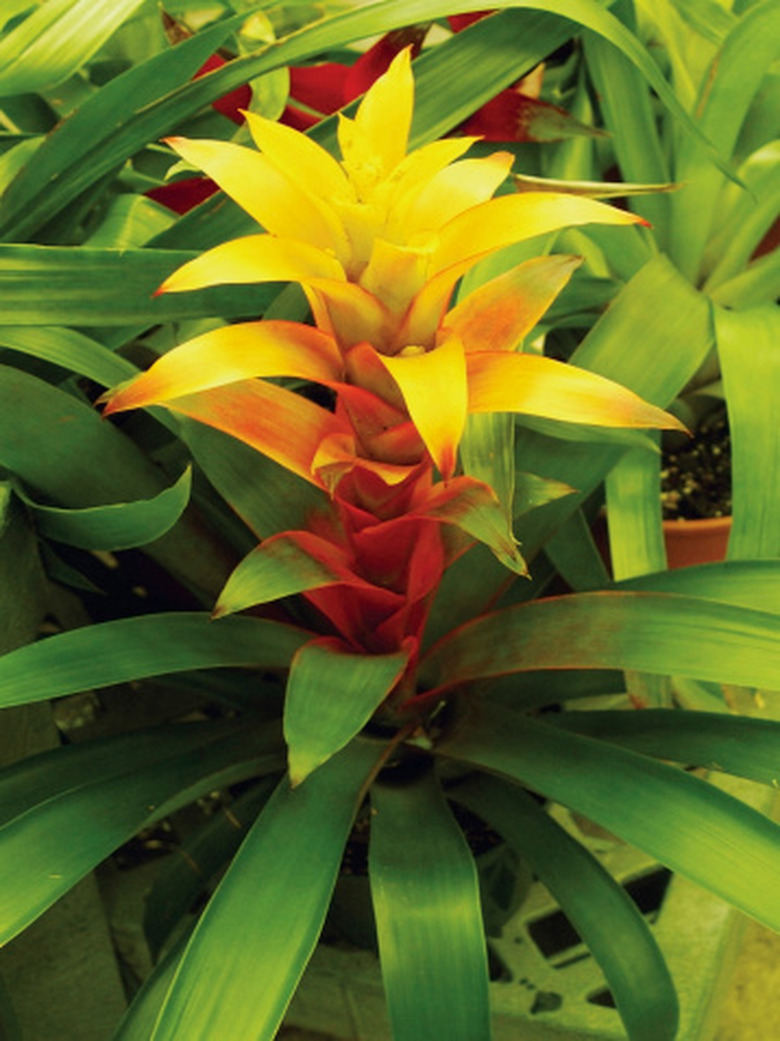What To Do If Your Bromeliads Are Brown
Bromeliads include a wide range of plant species, such as pineapples and Spanish moss, that all share two common traits. Their leaves are arranged in a spiral known as a rosette, and their leaves contain trichomes, which are shield-shaped clusters of cells known as scales. These scales have different functions such as helping to reduce water loss, absorbing moisture and protecting plants from radiation. Most bromeliads are grown for their colorful leaves, which can be gray, maroon, green, spotted or striped. Leaves that turn brown indicate a cultural problem or an attack by weevils.
Cultural Problems
Brown marks on bromeliad leaves can be a sign of overwatering or poor drainage, or an indication that the light is too strong. If just the tips of the leaves are brown, your plant might be too cold or dry, or it might be suffering from poor drainage. Brown leaves at the base of the plant indicate overwatering or poor drainage. Healthy plants naturally shed their bottom, or older, leaves, which turn brown as they age.
- Bromeliads include a wide range of plant species, such as pineapples and Spanish moss, that all share two common traits.
- Most bromeliads are grown for their colorful leaves, which can be gray, maroon, green, spotted or striped.
Care
Bromeliads don't like soggy soil and are prone to root rot if the soil stays wet. Porous soil allows water to drain quickly. Water bromeliads thoroughly and let the soil dry between waterings. Some bromeliads hold water in leaf cups called tanks. If your bromeliad has a tank, keep it filled all the time. Provide bromeliads with filtered light and warm temperatures between 60 and 70 degrees Fahrenheit. Bromeliads prefer humid air. Use a humidifier or mist plants frequently.
- Bromeliads don't like soggy soil and are prone to root rot if the soil stays wet.
Weevils
Adult Mexican bromeliad weevils damage plants by eating the leaves and flower stalks, but larvae cause even more damage by tunneling into the base of bromeliads and destroying the main stem and leaf tissue. Adults are black with a yellow or orange band across their wing covers. They grow to be about 1/2 inch long. Larvae are cream colored with dark heads.
Symptoms
Symptoms of weevil infestation include brown or decomposing leaves near the base of the plant and separation of the plant from the roots, which causes the plant to fall over. A clear, gelatinlike substance may also ooze from some plants.
Control
To control bromeliad weevils, University of Florida entomologists recommend using a reduced concentration of insecticides labeled for use on beetles and grubs. However, their recommendation isn't based on specific information because, as of 2010, no chemical trials of pesticides had been conducted against this weevil. Research on ways to control the weevil biologically led to the release of parasitical flies in 2007 and 2008 but, as of August 2010, no information was available about the results.
- Adult Mexican bromeliad weevils damage plants by eating the leaves and flower stalks, but larvae cause even more damage by tunneling into the base of bromeliads and destroying the main stem and leaf tissue.
- Research on ways to control the weevil biologically led to the release of parasitical flies in 2007 and 2008 but, as of August 2010, no information was available about the results.
